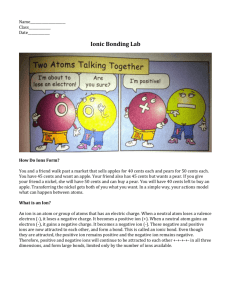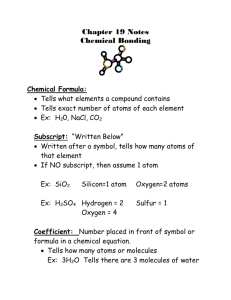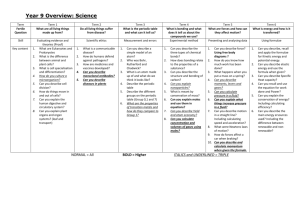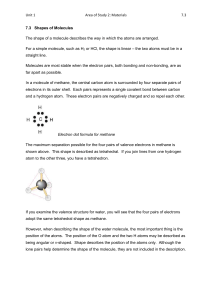TUTORIAL - UniMAP Portal
advertisement
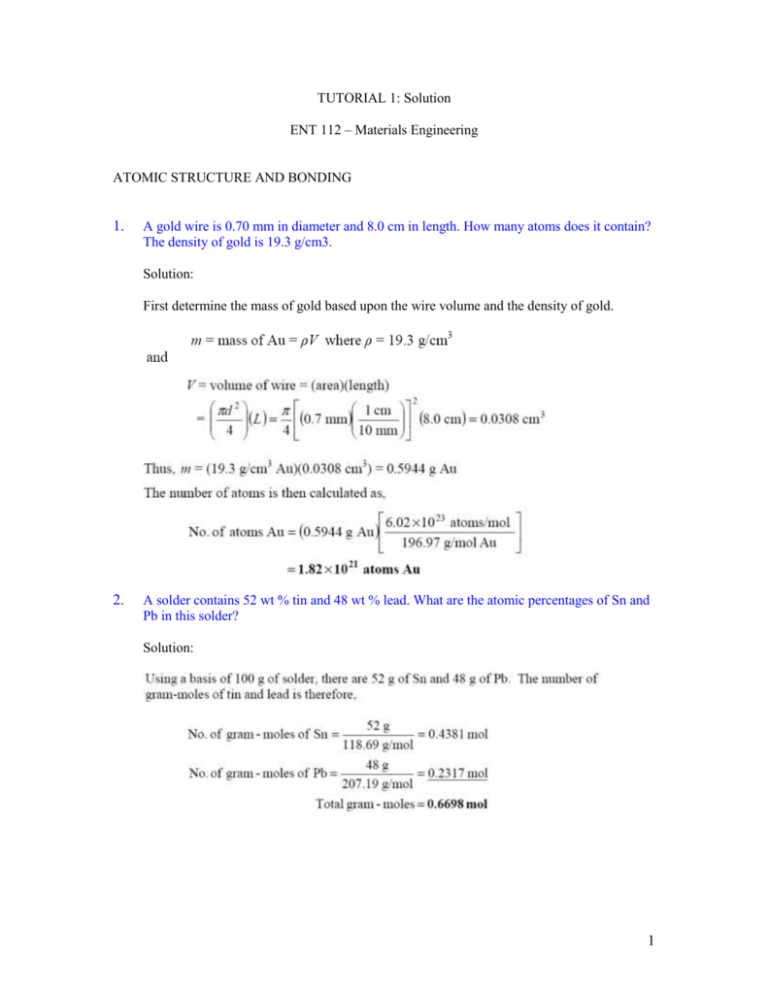
TUTORIAL 1: Solution ENT 112 – Materials Engineering ATOMIC STRUCTURE AND BONDING 1. A gold wire is 0.70 mm in diameter and 8.0 cm in length. How many atoms does it contain? The density of gold is 19.3 g/cm3. Solution: First determine the mass of gold based upon the wire volume and the density of gold. 2. A solder contains 52 wt % tin and 48 wt % lead. What are the atomic percentages of Sn and Pb in this solder? Solution: 1 3. Describe the ionic bonding process between a pair of Na and Cl atoms. i) Which electrons are involved in the bonding process? ii) After ionization, why is the sodium ion smaller than the sodium atom? iii) After ionization, why is the chloride ion larger than the chlorine atom? Solution: 4. i) The ionic bonding process between a pair of Na and Cl atoms involves a transfer of the outer 3s1 electron of the Na atom to the 3p vacancy in the Cl atom. Thus, the Na ion formed has the Ne electron configuration while the Cl ion has the Kr electron configuration. ii) After ionization to the Na+, the Na atom becomes smaller because the electron-toproton ratio of the Na atom is decreased when the Na+ ion forms. Also, the outer third shell no longer exists once the 3s1 electron is lost by the Na atom. iii) After ionization, the Cl- ion is larger because the electron-to-proton ratio of the chlorine atom is decreased by the ionization process. Briefly describe the following types of primary bonding: (a) ionic, (b) covalent, and (c) metallic. Solution: (a) Ionic bonding arises from the electrostatic attraction between oppositely charged ions. In the process of ion formation, an electron or a number of electrons may be transferred from a highly electropositive element to a highly electronegative one. The ionic bond in solids is nondirectional. (b) Covalent bonding is a primary type of bonding which arises from the reduction in energy associated with the overlapping of half-filled orbitals of two atoms. In this bond, there is an electron exchange interaction. The covalent bond is a directional type of bond. (c) Metallic bonding is a primary type of bonding involving the interaction of the valence electron or electrons of one atom with many surrounding atoms. This interaction leads to a reduction in energy of the system considered. The valence bonding electrons of these bonds are sometimes regarded as an ‘electron gas’ bonding the positive ion cores (atoms less their valence electrons) of atoms. The metallic bond is nondirectional. 2 5. If the attractive force between a pair of Cs+ and I- ions is 2.83 × 10-9 N and the ionic radius of the Cs+ ion is 0.165 nm, calculate the ionic radius of the I- ion in nanometers. Solution: 6. How can the high electrical and thermal conductivities of metals be explained by the “electron gas” model of metallic bonding? Ductility? Solution: The high electrical and thermal conductivities of metals are explained by the mobility of their outer valence electrons in the presence of an electrical potential or thermal gradient. The ductility of metals is explained by the bonding .electron gas. which enables atoms to pass over each other during deformation, without severing their bonds. 3




